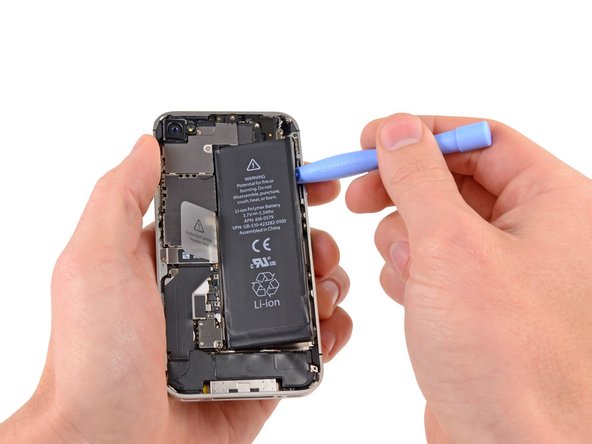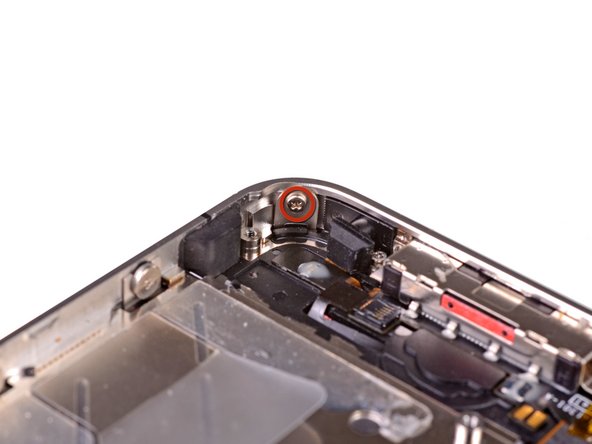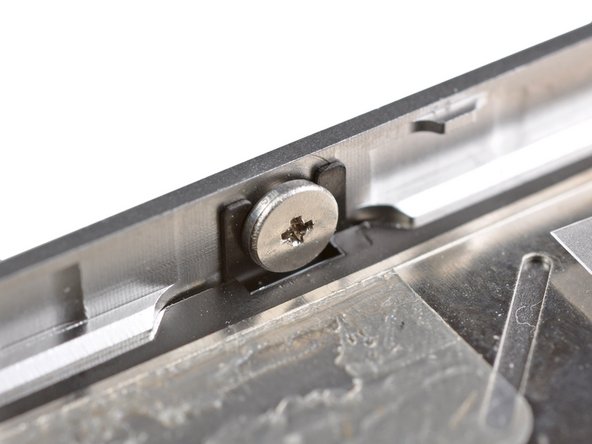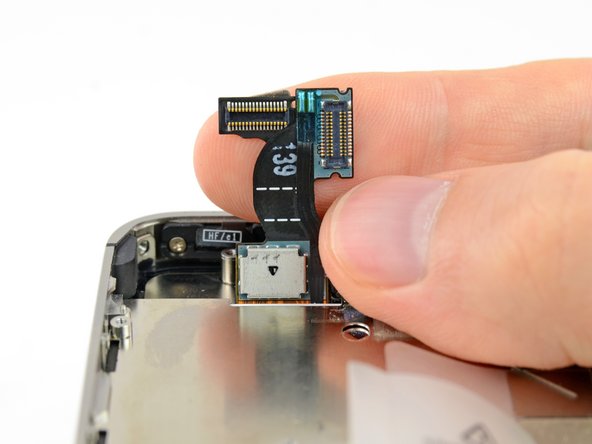How Much To Get Iphone 4s Screen Fixed

-
Before you begin, discharge your iPhone battery below 25%. A charged lithium-ion battery can catch fire and/or explode if accidentally punctured.
-
Power off your iPhone before beginning disassembly.
-
Remove the two 3.6 mm Pentalobe P2 screws next to the dock connector.
-
Be sure the driver is well-seated when removing Pentalobe screws—they are easy to strip.




-
Push the rear panel toward the top edge of the iPhone.
-
The panel will move about 2 mm.

-
Pull the rear panel away from the back of the iPhone, being careful not to damage the plastic clips attached to the rear panel.
-
Remove the rear panel from the iPhone.




-
Remove the following screws securing the battery connector to the logic board:
-
One 1.7 mm Phillips screw
-
One 1.5 mm Phillips screw



-
Carefully push the pressure contact away from the battery connector until it slides free from its position.
-
Remove the pressure contact.



-
Use a plastic opening tool to gently pry up the battery connector from its socket on the logic board.
-
Place the tip of the tool between the loudspeaker enclosure and the metal cover of the connector, and lift the bottom edge of the connector first.
-
The battery connector comes off vertically from the logic board. Do not apply force sideways.
-
Be careful not to pry at the battery connector socket itself, or it may detach from the logic board. There are four very small solder points awaiting this mistake!




-
During reassembly, be sure to carefully position the pressure contact back in place. It should rest on top of the Philips screw post shown, and the gold contact should point towards the battery connector.
-
Be sure to clean the pressure contact with a degreaser such as windex or isopropyl alcohol. The oils on your fingers have the potential to create wireless interference.




-
Insert the edge of a plastic opening tool between the battery and the outer case near the bottom of the iPhone.
-
Run the plastic opening tool along the right edge of the battery and pry up at several points to completely separate it from the adhesive securing it to the outer case.
-
If the adhesive is too strong, apply a few drops of high concentration (over 90%) isopropyl alcohol under the edge of the battery.
-
Wait about one minute for the alcohol solution to weaken the adhesive.
-
Use the flat end of a plastic opening tool to gently lift the battery.
-
Don't try to forcefully lever the battery out. If needed, apply a few more drops of alcohol to further weaken the adhesive. Never deform or puncture the battery with your pry tool.
-
If there's any alcohol solution remaining in the phone, carefully wipe it off or allow it to air dry before installing your new battery.




-
Use the exposed clear plastic pull tab to peel the battery off the adhesive securing it to the iPhone.
-
Be careful not to pull the plastic pull tab too hard as it can be ripped off very easily.
-
Remove the battery.
-
If your replacement battery came in a plastic sleeve, remove it before installation by pulling it away from the ribbon cable.
-
If your replacement battery came with an uncreased cable, carefully crease the cable into the proper shape before installing the battery into the phone.
-
While installing the replacement battery, temporarily connect the battery connector to the phone to ensure proper alignment. Once the battery is glued in place, disconnect the battery connector.
-
Perform a hard reset after reassembly. This can prevent several issues and simplify troubleshooting.




-
Remove the following screws securing the dock connector cable cover to the logic board:
-
One 1.5 mm Phillips screw
-
One 1.2 mm Phillips screw
-
Remove the metal dock connector cable cover.

-
Use the edge of a plastic opening tool to pry the dock cable up from its socket on the logic board.

-
Peel the dock connector cable off the adhesive securing it to the logic board and the side of the speaker enclosure.




-
Use the edge of a plastic opening tool to pry the cellular antenna cable up from its socket on the logic board.
-
De-route the cellular antenna cable out from under the metal fingers attached to the logic board.

-
Be wary of the outer plastic ring located on top of the rear camera's flash assembly. It can be easily displaced if not removed during disassembly.
-
You can use tweezers, a plastic opening tool, or a spudger to remove the outer plastic ring.

-
Remove the following four screws securing the cable cover to the logic board:
-
One 2.7 mm Phillips screw
-
One 2.6 mm Phillips screw
-
One 1.3 mm Phillips screw
-
One 1.2 mm Phillips screw




-
Use the edge of a plastic opening tool to pry the cable cover tabs out of their slots cut into the EMI shield on the logic board.
-
Lift the cable cover from its edge nearest the top and remove it from the iPhone.




-
Use the edge of a plastic opening tool to pry the rear camera connector up from its socket on the logic board.
-
Be careful not to break any components off the surrounding area on the logic board as you pry upwards.
-
Remove the rear camera from the iPhone.
-
There is a small rubber gasket that sits underneath the rear-facing camera. Make sure that it is properly seated before reassembly.




-
Use a SIM eject tool or a paperclip to eject the SIM and its tray.
-
This may require a significant amount of force.
-
Remove the SIM and its tray.




-
Remove the five cables near the top of the logic board in the following order:
-
Headphone jack/volume button cable
-
Front facing camera cable
-
Digitizer cable
-
Display data cable
-
Power button cable (located underneath the headphone jack/volume button cable as shown in the second picture.)
-
To disconnect the cables, use the edge of a plastic opening tool to gently lift their connectors up and out of the sockets on the logic board.
-
Be careful not to break any of the small and delicate surface mount components as you disconnect the cables.

-
Remove the 1.5 mm Phillips screw securing the grounding clip to the logic board near the headphone jack.




-
Use the tip of a spudger to pry the small grounding clip up off the logic board.
-
Carefully grasp the grounding clip and remove it from the iPhone.
-
Before reassembly, be sure to clean all metal-to-metal contact points on the grounding clip (not the mating halves of connectors) with a de-greaser such as windex or isopropyl alcohol. The oils on your fingers have the potential to cause grounding issues.

-
Remove the 4.8 mm standoff screw near the headphone jack.
-
Standoff screws are best removed using a standoff screwdriver or bit.
-
In a pinch, a small flathead screwdriver will do the job—but use extra caution to ensure it doesn't slip and damage surrounding components.

-
Use the edge of a plastic opening tool to disconnect the Wi-Fi antenna from the logic board.




-
If present, peel the piece of black tape covering the hidden screw near the power button.
-
Remove the 2.6 mm Phillips screw securing the logic board near the power button.
-
(Use caution when removing this screw and removing the power contact held by it; the contact tab will come loose with the screw)
-
Notice the small rubber bumper under the screen & digitizer cables (which are detached at top above the Q-code). This bumper can fall off of the logic board when removed or get stuck to the cables and fall off later.

-
Remove the following screws securing the logic board to the case:
-
One 2.5 mm Phillips screw near the vibrator motor
-
One 2.4 mm Phillips screw
-
One 3.6 mm standoff along the side of the logic board nearest the battery opening.
-
Use a standoff driver bit and driver handle to remove the single 3.6 mm standoff screw.
-
In a pinch, a small flathead screwdriver will do the job—but use extra caution to ensure it doesn't slip and damage surrounding components.

-
Carefully lift the logic board from the end closest to the speaker enclosure and slide it away from the top edge of the iPhone.
-
Remove the logic board.
-
Before reassembly, be sure to clean all metal-to-metal contact points on the logic board (not the mating halves of connectors) with a de-greaser such as windex or isopropyl alcohol. The oils on your fingers have the potential to cause grounding issues.
-
There is a small rubber bumper that sits on the top edge of the logic board where the digitizer and screen cables come through the case. It protects the cables as they bend over the top of the logic board. This can either get stuck to the cables or fall off the logic board when it comes out. Look back over step 22 for more details.

-
Be sure not to lose the small grounding finger for the rear facing camera near the power button. This finger rests on top of the PCB, screwed down, and covered with the adhesive black plastic tape.



-
Wedge the plastic opening tool between the vibrator and the side of the iPhone.
-
Pry the vibrator up to release it from the adhesive securing it to the iPhone.
-
Remove the vibrator.

-
Remove the two 2.4 mm Phillips screws from the sides of the speaker enclosure assembly.

-
Remove the small plastic bracket that was installed under the screw closest to the dock connector cable.




-
Remove the speaker enclosure assembly from the iPhone.
-
Before reinstalling the speaker enclosure assembly's screws, be sure the Wi-Fi grounding fingers are installed below the lip in the iPhone's metal case as seen in the second picture.
-
Before reassembly, be sure to clean all metal-to-metal contact points between the grounding fingers of the Wi-Fi antenna and the case of the iPhone with a de-greaser such as windex or isopropyl alcohol. The oils on your fingers have the potential to cause wireless interference issues.

-
Remove the small pieces of black tape covering the display mounting tabs.
-
Note: These corner screws are not the same thickness as the other 1.5mm screws. Set them aside separately.

-
Remove the 1.5 mm Phillips screw securing the display assembly near the power button.

-
Remove the 1.5 mm Phillips screw near the headphone jack.
-
Removing the headphone jack makes it easier to access this screw, particularly during reassembly. If you're having trouble, refer to this section of the iPhone 4S Headphone Jack Cable guide to remove the headphone jack.

-
Remove the 1.5 mm Phillips screw near the lower microphone.

-
Remove the 1.5 mm Phillips screw near the dock connector cable.




-
Loosen the three large-headed Phillips screws along the volume button side of the iPhone about one half turn.
-
It is not necessary to completely remove these screws. When reinstalling the display assembly, be sure the washers are closest to the screw head (as seen in the second picture).

-
Loosen the three large-headed Phillips screws along the other side of the iPhone about one half turn.

-
Use the edge of a plastic opening tool to gently pry up the display assembly around its perimeter.

-
Remove the display assembly from the iPhone.




-
To successfully install a new/replacement display assembly, note the following:
-
Remember to switch the home button from your old display to the new display (in most cases, this is not provided). The home button gasket is thin rubber, so care must be taken not to tear it. Also, check that the mesh for the speaker hole is present in the replacement; if not, move it over from the old display.
-
Be sure to peel off the protective backing (usually blue or pink) from the new panel before installing it.
-
If your replacement display does not come with a 7 mm clear plastic ring surrounding the front-facing camera, be sure to transfer it between the old and new display.



-
Whether installing a replacement display assembly or re-using the existing display assembly, note the following:
-
Carefully straighten the digitizer and LCD data cables, and feed them through the slot cut in the outer case.
-
The middle photo shows the digitizer cable being correctly fed through to its full length.
-
This photo shows the display assembly being installed incorrectly, with too much slack in the digitizer cable, which then forms a bend/loop that gets caught in the slot. The third photo also shows this loop.
-
If the digitizer cable has been installed incorrectly, it will not reach its socket on the logic board. Do not attempt to pull it through by force, or it will be cut by the sharp edge of its slot in the enclosure. Remove the display assembly, straighten the cable, and re-feed the cable through completely and correctly.

-
During reassembly, do not touch the metallic area at the base of the LCD data cable, as this can cause problems with the LCD. If you do touch it accidentally, clean it gently with an alcohol wipe before continuing.
-
After reassembly, clean the touchscreen surface with an alcohol wipe prior to turning the iPhone back on. The alcohol helps dissipate any lingering static electricity, which can cause problems with the display.
-
After reassembly, connect the iPhone to an AC power source before turning it on for the first time. Once the iPhone has booted up successfully, you can disconnect the AC power.
-
After reassembly, protect your new display from any scratches by installing a new screen protector.
How Much To Get Iphone 4s Screen Fixed
Source: https://www.ifixit.com/Guide/iPhone+4S+Screen+Replacement/7277
Posted by: collinshimmuch.blogspot.com

0 Response to "How Much To Get Iphone 4s Screen Fixed"
Post a Comment